International Overdose Awareness Day was first celebrated in Melbourne, Australia in 2001 as a local gathering of remembrance for those in their community affected by overdose. In 2012, the Penington Institue stepped in the not only help organize events, but take this significant day global. Now, thousands of events across over 40 countries take place on or around August 31st in honor of loved ones and in a pursuit to prevent future overdoses.

According to the United Nations Office on Drugs and Crime (UNODC), the estimated number of people using opioids around the world has nearly doubled from 26-36 million people in 2010 to 61.3 million in 2020.1
While the Opioid Epidemic is a global trend, the type of opioids that are popular vary from region to region. Canada and the US sees a rise of popularity of fentanyl and countries in North and West Africa and the Middle East see an increased use of tramadol.1
The rise of fentanyl poses a high risk of overdose, especially you and young adults in Michigan. Fentanyl is 50x stronger than heroin and 100x stronger than morphine.2
In 2022, 80% of drug overdose deaths in Michigan were from an opioid overdose.2
When looking at the US specifically, while overdose rates remain high by historical standards, a decline in overdose rates have recently been reported. Data shows that between October 2023 and September 2024 has had the fewest overdose related deaths in any 12-month period since June 2020.1 Despite this, people of color are disproportionately impacted by the opioid crisis.3
Though overdose rates are still high in Michigan, they did follow a similar decline that the US showed. Between 2023 and 2024, the number of opioid overdoses in Michigan decreased by over 33%.4
Naloxone is a drug which blocks opiate receptors in the nervous system and rapidly and temporarily reverses the effects of an opioid overdose. OPEN is working to reduce opioid-related overdoses by expanding access to naloxone to high-risk communities across Michigan. Through collaboration with organizations and institutions statewide, we are making naloxone more accessible to get into the hands of patients, family members, caregivers, and community leaders.

According to the American Society of Addiction Medicine, addiction is a treatable, chronic medical disease that involves complex brain circuits, genetics, the environment one lives in, and an individual’s own life experiences.
When looking at the neurobiology of addiction, it is important to remember that some people who partake in drug use will not develop an addiction. There are several factors that play a role in one’s risk of addiction, including both environmental and genetic components. Those who do go on to develop addiction will begin to engage with substance use that becomes compulsive and will continue to do so despite harmful consequences.
Addiction can be treated using a multidisciplinary approach. Treatment options include treatment with medication (the gold standard for opioid use disorder), therapy to rebuild areas of the brain damaged by addictive substances, meaningful and supportive human connection and engaging in purposeful activities to strengthen the reward pathway.
Addiction is a treatable condition, and together, we can move towards a future with reduced stigma and higher access to resources for those living with addiction.